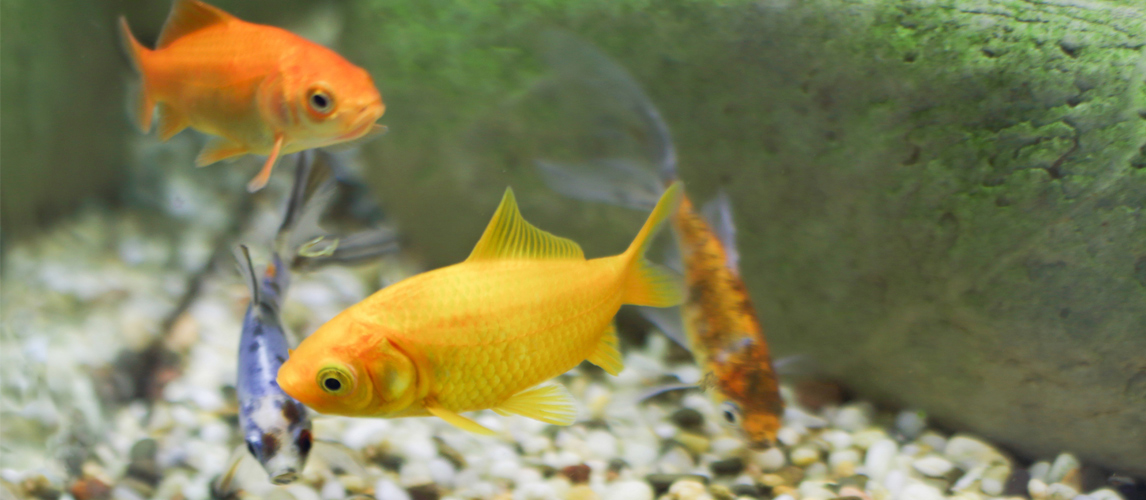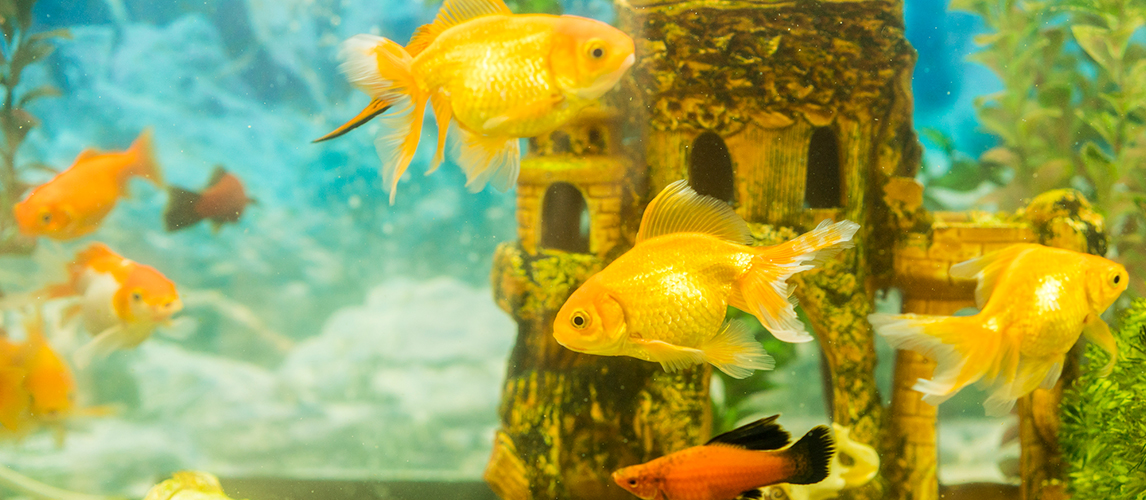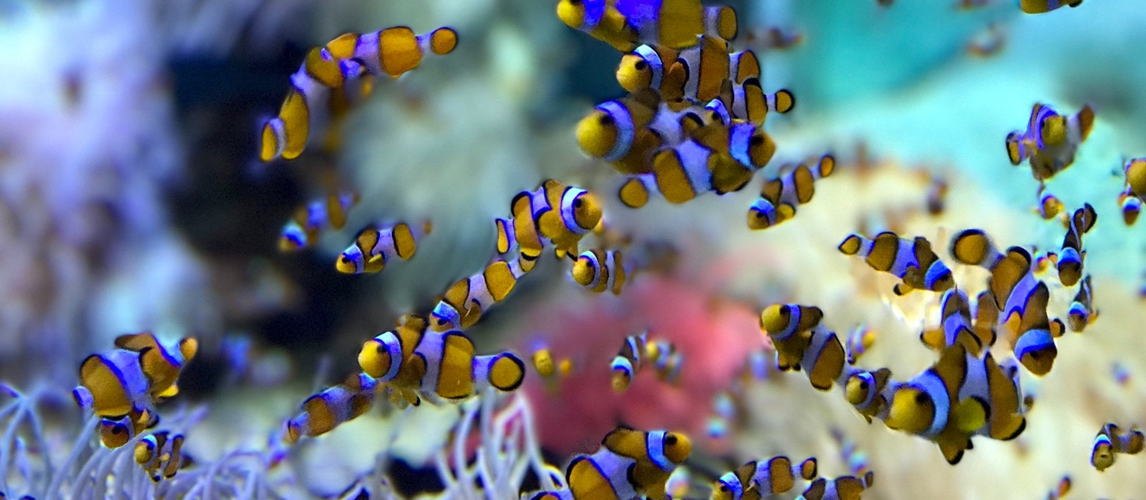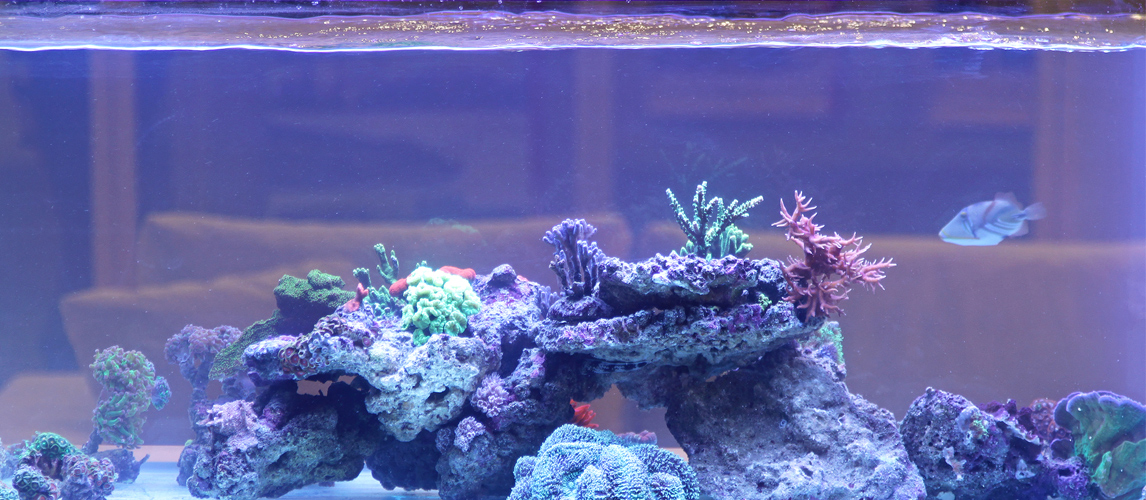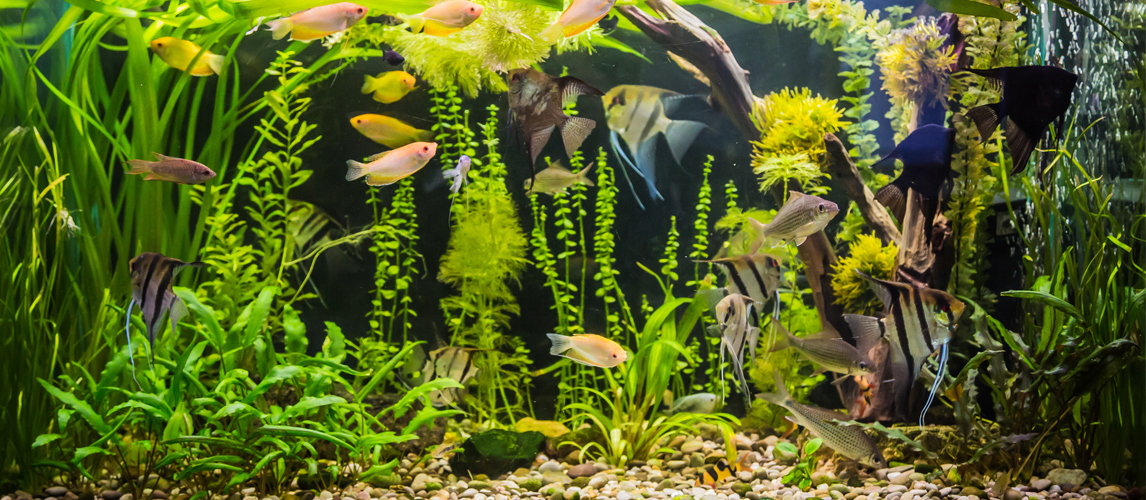
The Best Aquarium Pumps in 2022
- Home
- Other animals
- Fish
Do you have an aquarium? If so, you may be considering buying an air pump for it. It’s a common misconception that an air pump increases the amount of oxygen in the water and it’s for this reason that it’s necessary for the health of the fish. However, that’s simply not the case. In broad terms, a fish tank air pump is designed to improve the circulation of air in the aquarium by sending small bubbles up to the surface, which then pop. This motion then agitates the surface, increasing the surface area over which gas exchange can take place.
An air pump is often needed to improve the functioning of other features in your tank, such as filters that are driven by air; some ornaments with spinning wheels or turning valves that require air to drive them; and air stones, which create a flow of tiny bubbles that help move air through a filter.
You might also use an air pump to ensure there’s a current in the water, which stops stagnation in specific parts of the tank. If your tank is home to semi-aquatic animals, an air pump will help aerate the whole enclosure.
So the type of air pump you buy will very much depend on the use(s) you’ll put it to. With that in mind, read on to discover some of the features of our pick of aquarium pumps on the market.
Related Post: Best Aquarium
The Best Aquarium Pump
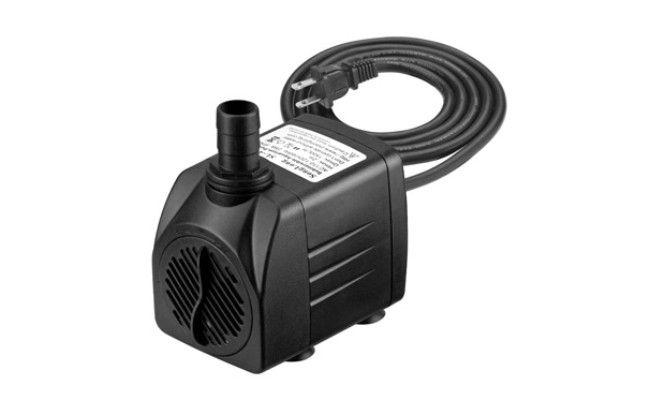
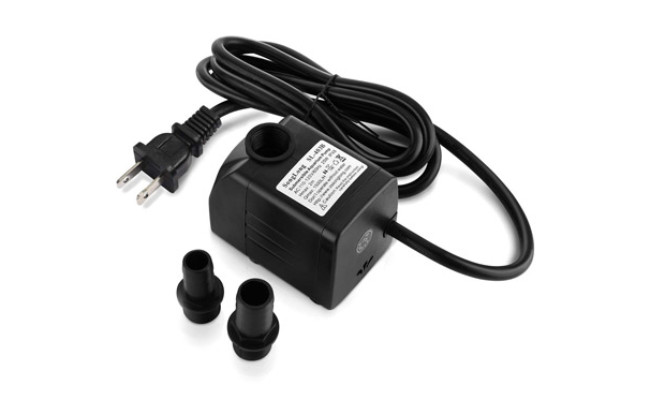


The Homasy 400 GPH Submersible Pump again is a unit which can be installed within an aquarium, tank and so on. Four suction cups are included with the pump, so it can be fitted stably and securely to any inner aquarium wall, yet is easy to detach when needed.
The maximum flow rate is a generous 400 GPH, but the output of bubbles can be dialed down if needed with a built-in control knob on the side. There are also two differently sized nozzles (0.51” and 0.62”), so using the smaller can decrease the flow rate too if that’s desirable. The power cable is around 5ft9, making it ideal for smaller installations and with a 25W motor, your energy bills won’t leap up either. The unit is relatively quiet while in operation, helped by the fact that it can be submerged within the tank which deadens the noise.
If excess noise is produced, this is usually a sign that the impeller shaft and other working parts need cleaning, but as the former is constructed from stainless steel, there will be little in the way of corrosion and you should find this pump lasts well, despite its wet environment.
The product comes with a full year’s warranty and lifetime technical support is available if you experience any problems or have questions about your purchase.
Dimensions: 6.1” x 3” x 4.5”
Weight: 1.4lbs
Maximum Flow Rate: 400 GPH
Maximum Lift Height: 6ft 9”
Power: 25 Watts
Length of Power Cord: 5ft 9”
- Brand: Homasy
- Model: USAA1-VTGECD043AB-VD
- Weight: 1.3 pounds
Good value for money
Incredibly easy to clean
It is as silent as promised
It is not long-lasting
The cord is too short
It is not as powerful as advertised
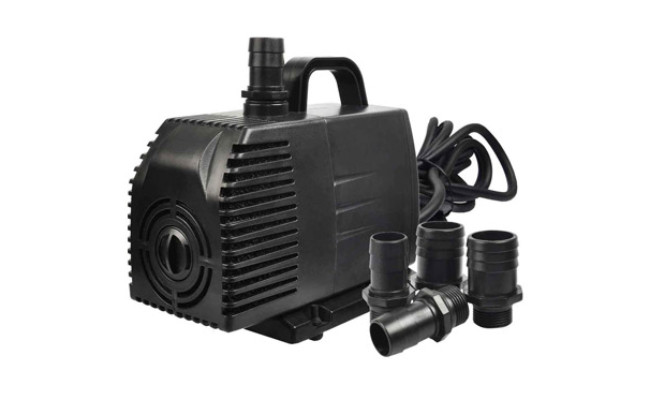
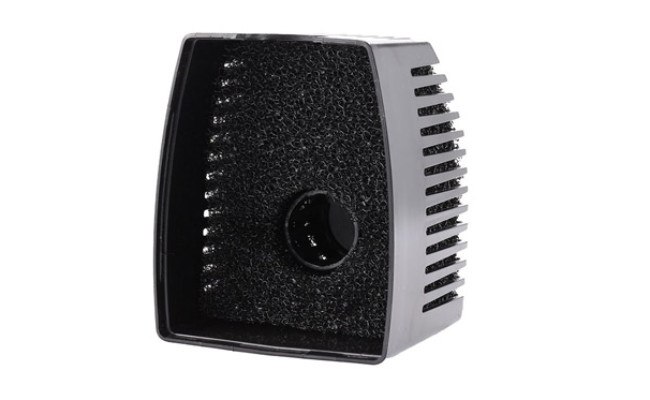


Top of our list is the Simple Deluxe 1056 GPH Listed Submersible Pump. As well as positive reviews on its performance, it’s also packed with features that ensure this is an investment that will last, ensuring you get value for money.
For instance, this pump has a pre-filter included in the price, which helps prevent debris from entering your aquarium pump which could shorten its useful lifespan, as well as impacting on how noisy it is while in operation. The impeller shaft is also constructed from polished Aluminum Oxide Ceramic, which is more than triple the strength of stainless steel and won’t corrode in water either. All working parts are encased in epoxy resin, which ensures they’re protected from corrosion too.
As it’s a submersible aquarium filter pump – in other words, it sits within the water in the tank itself instead of being mounted on the exterior – the safety of your fish is an important consideration. Here, you’re covered: the unit has no exposed copper and is guaranteed safe for fish.
More than that, the pump is easy to take apart when the impeller and/ or filter need cleaning – no tools are required. The lengthy power cord, a generous 15ft, is also waterproofed and designed to withstand wear and tear from moisture, oil, grease and variations in temperature. The unit comes with three nozzles (0.83”, 1.06” and 1.34”) so you can select the right one for your set-up; and the fittings are threaded to increase stability.
The manufacturer also makes pumps with maximum flow rates of 80 GPH, 160 GPH and 290 GPH.
Dimensions: 8.3” x 4.6” x 7.1”
Weight: 4.5lbs
Maximum Flow Rate: 1056 GPH
Maximum Lift Height: 12ft
Power: 60 Watts
Length of Power Cord: 15 feet
- Brand: Simple Deluxe
- Model: LGPUMP1056G
- Weight: 4.5 pounds
It is very well-built
Well-sealed to avoid electrocuting the fish
The cord is long enough for manipulation
Durability is questionable
It gets clogged up easily
Not suitable to be used in ponds
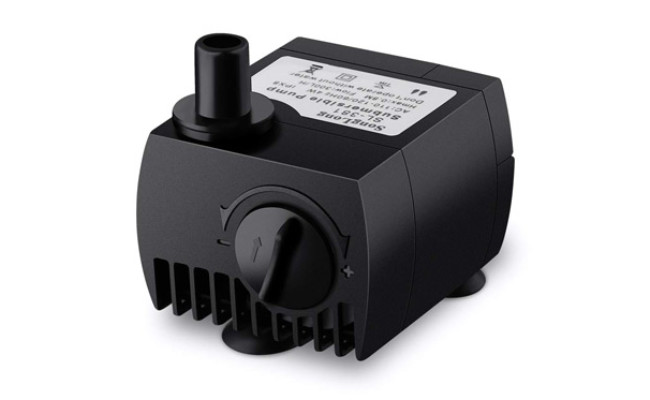
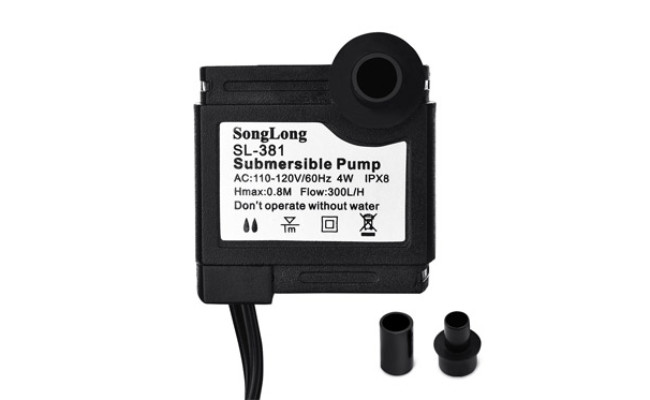


The VicTsing Submersible Water Pump has a maximum flow rate of 80 GPH, but this is flexible as the unit enables you to adjust the water flow to create exactly the degree of pressure you need. In fact, this is a highly versatile pump for a range of uses, as it also comes with four suction cups which are strong enough for you to be able to place it either vertically or horizontally on any stable surface within an aquarium, fountain, hydroponic system or other set-up.
The impeller is made of stainless steel, which is resistant to corrosion and will help extend the lifespan of your pump. As an added benefit, the unit is easy to strip down and keep clean when needed – no tools are required to get at the moving parts.
Two nozzles are included (0.33” and 0.51”) to help adjust the flow to a suitable rate for your set-up. For those worried about noise, the unit promises to be ultra-quiet when in operation, so it’s great for indoor locations such as the bedroom. The unit is also compact in size, making it a great space-saving addition for smaller tanks or fountains.
There’s a 12-month warranty on the product and after-sales care which promises to resolve any issues within 24 hours.
Dimensions: 1.87” x 1.68” x 1.24”
Weight: 5.3oz
Maximum Flow Rate: 80 GPH (300 liters per hour)
Maximum Lift Height: 2.6ft
Power: 4 Watts
Length of Power Cord: 5ft 9”
- Brand: VicTsing
- Model: SYNCHKG044575
- Weight: 5.3 ounces
It is portable yet powerful
There’s no loud noise associated with the pump
It is easily adjustable
The tubing size is not suitable for aquarium sizes
It is not well-grounded, so it’s a shocking hazard
It is not sturdy
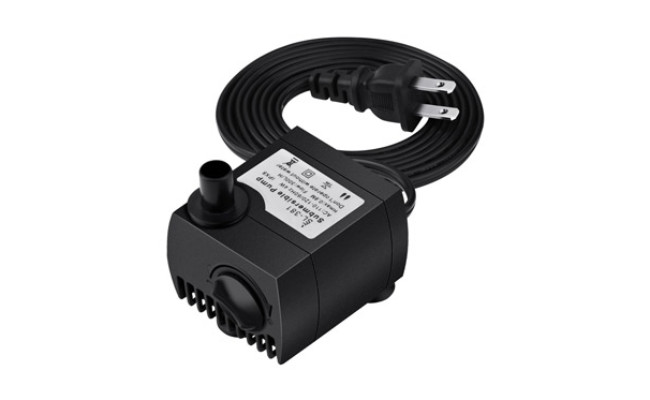
All bodies of water need some cleaning out once in a while. Out in nature, the current does its best to take care of that, but in an aquarium, a water pump helps the filter get it done. With the Homasy 80 GP Submersible Water Pump, small to medium aquariums, the mini fountain as well as water gardens have a sure way of being cleaned out. Thanks to its compact size, it is incredibly easy to conceal in the water, it blends in with the general aesthetic of the fish tank. Installation is also a breeze thanks to the suction cups attached; it can easily be mounted onto any glass surface. There’s no need for any tools, drilling or tinkering, just slap it on the right spot and it is good to go.
The fact that it is has a noiseless motor makes it the perfect indoor fixture, this does not take away from the efficacy of the motor. Additionally, its stellar design is a great perk, it has a knob that makes it incredibly easy to adjust the flow rate to an optimum level.
Noiseless motor
Detachable for cleaning
Comes with two nozzles
Multifunctional
- Brand: Homasy
- Model: FBA_VS-HG16-2
- Weight: 5.8 ounces
Comes with two different sized attachments
It runs slow and steady
Moves a good volume of water for its size
It is incredibly loud
Durability is questionable
It is a fire hazard
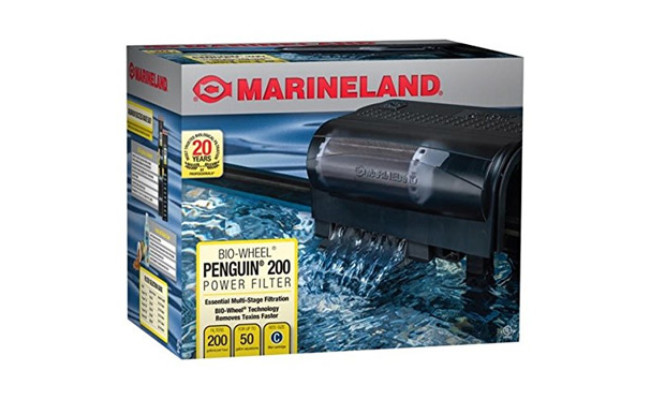
The MarineLand Penguin is a pump and filter all in one, with a certified flow rate of 200 GPH, making it ideal for aquariums holding around 30 to 50 gallons of water. Smaller and larger sizes are also available in the same range.
The filter feature offers mechanical and chemical filtration of aquariums and the price includes the required carbon filter cartridges (one or two, depending on the size of unit purchased). These can be cleaned periodically and reused. A BIO-Wheel is also included – this ensures biological filtration of your tank, removing nitrites and ammonia. The BIO-Wheel does not need replacement on regular basis, as it’s designed to help promote healthy bacteria in the water.
The manufacturer’s recommendation is that the filter is fitted around half to three-quarters of the way down the tank, to suck floating debris out of the water without disturbing sand or gravel on the base of the tank.
The filter system has a three year warranty against defects caused during the manufacturing process.
Dimensions: 9.5” x 6.2” x 8”
Weight: 13.6 oz (shipping weight)
Maximum Flow Rate: 200 GPH
Maximum Lift Height: Not specified
Power: 20 Watts
Length of Power Cord: Around 5ft
- Brand: MarineLand
- Model: PF0200B
- Weight: 2.3 pounds
Bio-wheel and filters are easy to clean
Two filters can be used at once
Keeps the fish tank clean and pristine
It does not make provision for adjustable flow
Can be quite noisy
Poor design and support
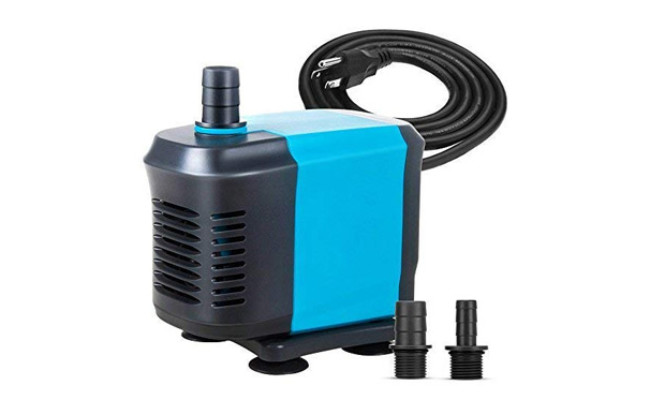
The KEDSUM 320 GPH Submersible Pump is a small, neat unit, that’s designed to be easy to conceal and not spoil the overall look of your tank. It can be mounted either vertically or horizontally within an aquarium or other water feature, but naturally should be fully submerged within water for correct operation. It’s low on power consumption too, at 20 Watts, and won’t create excessive noise pollution either – it’s advertised as being an ultra-quiet design. Despite its small size, though, it packs a powerful punch: the maximum flow rate is 320 GPH, or 1500 liters per hour and the maximum lift height is around 4ft.
Water flow can be controlled by using either of the two outlet adapters that come with the unit – you can choose between the 0.51” or 0.63” nozzles, the smaller of which will reduce the maximum flow rate. It’s easy to detach for moving or cleaning, which should be done with any aquarium pump from time to time to remove any debris that might affect its operation or increase the noise it makes while in use.
It’s designed to work effectively at temperatures between 0oF to 95oF (0oC to 35oC), but is or indoor use only – not suitable for garden water features, therefore, for instance. It can, though, be used in either salt or fresh water.
Dimensions: 3.2” x 3.9” x 2.4”
Weight: 15.2oz
Maximum Flow Rate: 320 GPH
Maximum Lift Height: 4ft
Power: 20 Watts
Length of Power Cord: 4ft 2”
- Brand: KEDSUM
It is quiet and efficient
Good value for money
Has a good flow rate
Durability may pose a problem
It is lightweight
Underpowered
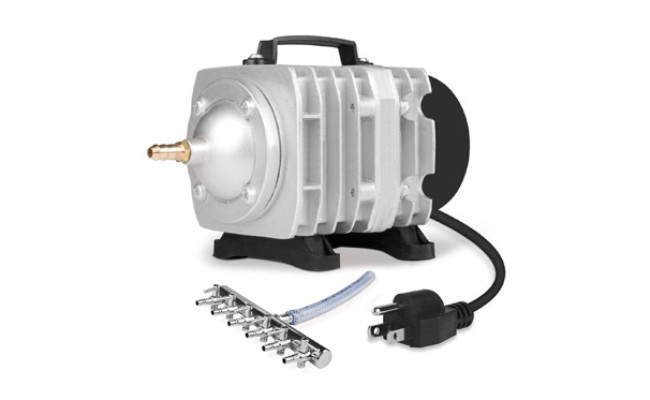
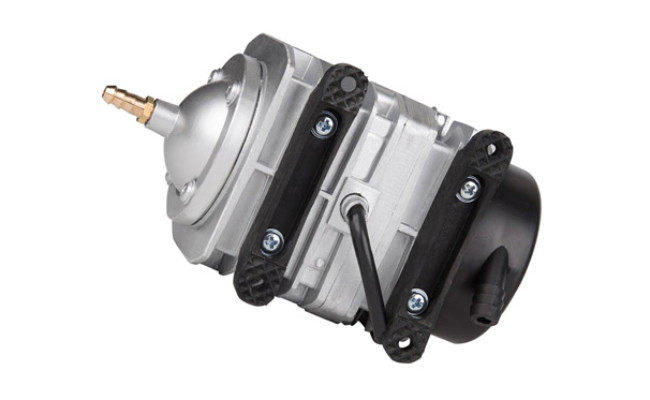


One of the Vivosun Air Pump’s key features is that it is suitable for outdoor use. It’s also energy efficient and built to resist wear and tear, so can be operated 24/7 once put in place in your aquarium or hydroponics system. It has a massive GPH of 950 which equates to around 60 liters of air per minute. There are six valve outlets, meaning it could work over six separate aquariums or positioned in different places within one to ensure an even flow of bubbles throughout the water volume. Each valve is adjustable so the flow can be altered according to requirements. However, you’ll need to supply your own tubing (1/4” air-line tubing required), air stones and so on.
The power cable stretches around 5ft, so you may also need an extension cord. The unit is relatively quiet for an outdoor pump with a measured low noise generation of under 60 decibels.
It’s relatively low maintenance too. Made from aluminum, it will resist corrosion. The unit does not require lubrication with oil, just a wipe down with a soft cloth and soapy water; and the filter sponge only needs cleaning every two months or so.
The same manufacturer makes both larger and smaller wattage units in the same range. This air pump comes with a three year warranty and full support from the company’s customer service team if you encounter any difficulties.
Dimensions: 8.9” x 5.1” x 4.6”
Weight: 3.77lbs
Maximum Flow Rate: 950 GPH
Maximum Lift Height: Not specified
Power: 32 Watts
Length of Power Cord: ~5ft
- Brand: VIVOSUN
- Weight: 3.75 pounds
Comes in a great size
It is quite powerful
Quiets down over time
Overheating is a standard issue
Starts out quite loud
Not long lasting
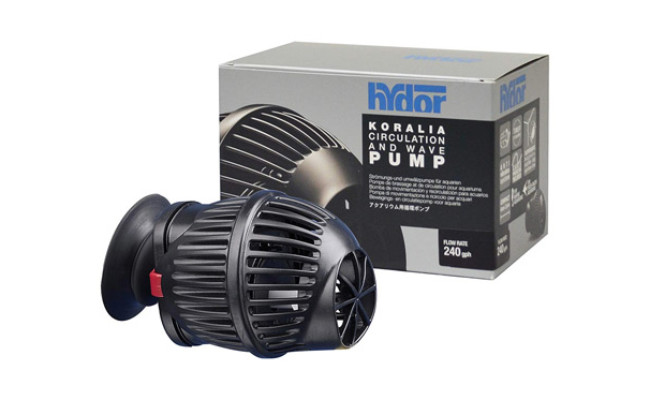
Even if it’s coming from a machine, water movement should seem natural, not unruly or simply non-existent. With a water pump like the Hydor Koralia Nano Aquarium Circulation Pump, your fish will experience the realistic motion of oceans and streams, with additional perks. The overall design of this water pump features a portable fixture that comes equipped with a patented magnet suction cup. This makes it incredibly easy to position it safely away from the water, but where it can do the most work. This energy saving aquarium water pump can equally be connected to a controller. This controller can conveniently be used to program intervals by the second, minute or hour. In addition to the timer, it is also equipped with wavemaker systems. To top it all off, every part of this device is well catered for, it comes with a much-needed cable protector as well as suitable instructions for how to position it.
The best place to make use of the Hydor Koralia is in saltwater or freshwater aquariums that need a tad bit more of circulation.
Portable fixture
Patented magnet suction
Energy saving
Multifunctional
- Brand: Hydor
- Model: P29101
- Weight: 6.4 ounces
It has a great flow rate
Has a solid build and structure
Easily positioned thanks to magnets
It is extremely loud
Short lifespan
The suction is hazardous to fish
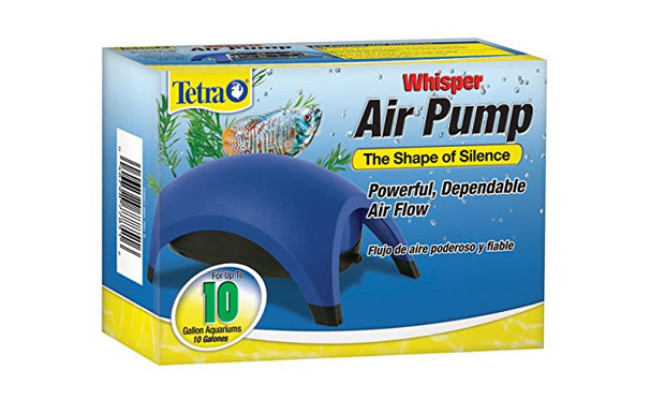
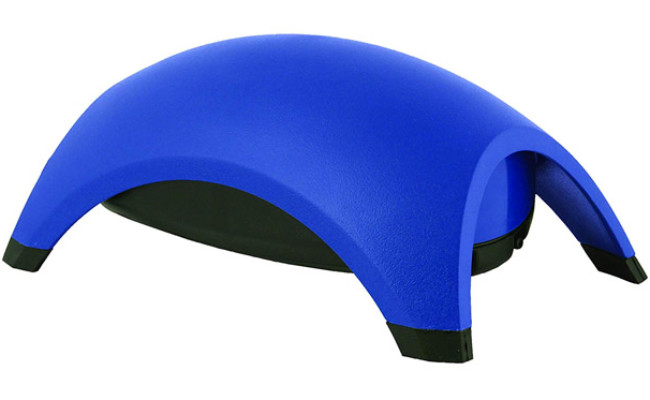


Available for a budget price, the Tetra Whisper Easy to Use Air Pump comes in different sizes depending on the size of your aquarium, from this one (up to 10 gallons) to one that can aerate a 60-100 gallon tank. While this particular model does not include air flow adjustment or multiple outlets, others higher up the range, for larger tanks, do.
The manufacturer boasts about the quietness of the unit, and customer reviews seem to back that up! The design incorporates sound dampening chambers and the housing is dome-shaped, which helps contain and reduce noise. This makes it ideal for indoor use as a fish tank pump, particularly where quiet operation is a bonus, such as aquariums kept in bedrooms. Where there is any excess noise emitted, it’s usually down to a factor that’s easily resolved, such as tightening the plastic housing.
With the 10 gallon unit, you get the pump itself, the connected power cord and a T-shaped adapter, which can be used to divide the air flow between two hoses (which you’ll need to supply).
As well as coming with a lifetime limited warranty, Tetra also offers free help and advice online and via a free downloadable app, so buy this product or any other in the Tetra range and you know your purchase is fully supported.
Dimensions: 3.9” x 2.8” x 5.5”
Weight: 12oz
Maximum Flow Rate: 30 GPH/ 136 liters per hour
Maximum Lift Height: Not specified
Power: 15 Watts
Length of Power Cord: Not specified
- Brand: Tetra
- Model: 77851
- Weight: 0.16 ounces
The airflow is adjustable
Good value for money
It is sturdy and powerful
Incredibly noisy and it gets noisier over time
Magnet tends to loosen up
Short lifespan
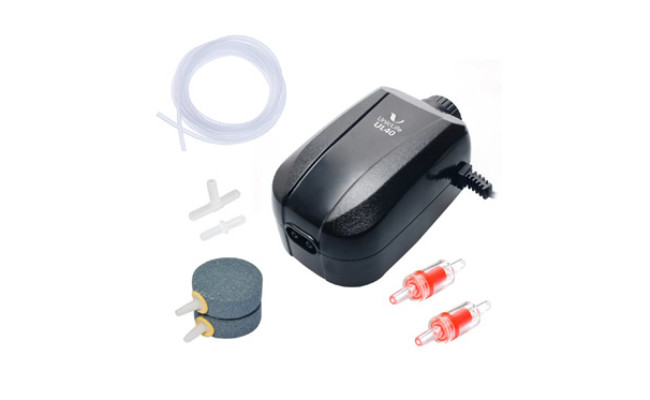
This Uniclife Aquarium Pump is an in-line pump (ie not submersible) great for both salt- and freshwater tanks and can cope with any volume of water from 20 to 100 gallons. The air flow is adjustable via a rotating dial mounted on the side, and with two outlets, you can use it to aerate two separate tanks or position the air stones separately within the same tank for better coverage.
Despite its potential power, though, it’s guaranteed to be a quiet unit that will fit well into indoor environments, with a noise output of around 25 decibels when run at its lowest flow rate. If you find it too noisy when set at higher levels (which still only reach a maximum of 40dB), a small blanket underneath the unit will help deaden noise. Most reviewers, though, comment extremely positively on the quietness of this product, especially in comparison with others at the same price point.
One pleasing factor about the Uniclife Air Pump is that it comes with everything you need in the box when it arrives: as well as the pump, you’ll receive two air stones, two return valves, 2 meters worth of air line and two connectors. There’s also a one year warranty in case anything goes wrong.
Dimensions: 5.1” x 2.8” x 2.5”
Weight: 1lb (shipping weight)
Maximum Flow Rate: 64 GPH or 290 Liters per hour
Maximum Lift Height: Not specified
Power: 4 Watts
Length of Power Cord: 6ft
- Brand: Uniclife
- Model: Uniclife-UL080
- Weight: 1.2 pounds
It is quiet and a nice bubbler
It is small but powerful
The air pressure is adjustable
It cannot support more than 20 gallons
It cannot operate more than 2 sponge filters at once
Not much on control and durability
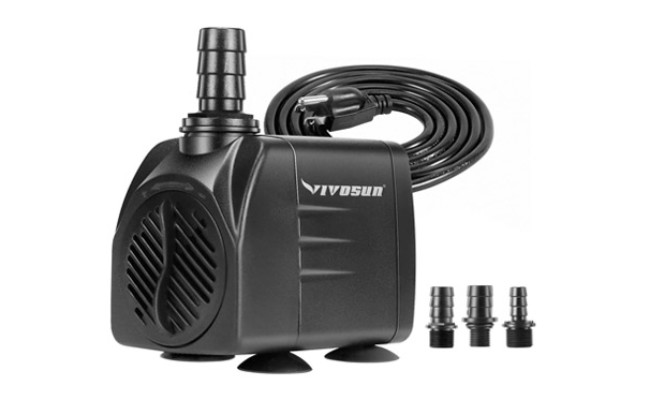
A simple design that works brilliantly for freshwater aquariums (though it is not suitable for saltwater choices), this submersible pump will work anywhere you need it, within your tank. The 5ft long power cord is the ideal length for most tanks, though it won’t stretch quite to where you need it without an extension cord.
It is easy to assemble and disassemble, as well as to split up and clean when required, to help keep your tank in top condition. It is extremely powerful and therefore ideal for larger tanks. That does, of course, mean it’s not a great choice for smaller tanks, as it can be a little too strong for these. Despite this, it’s highly energy efficient and compact, and therefore perfect for the majority of large aquariums.
5ft long three-core power cord
Max Flow Rate: 480 GPH (1800L/H)
Watt: 25W; Voltage:AC110V
Comes with 12-month warranty
Dimensions: 6.1 x 4.21 x 3.58 inches
- Brand: VIVOSUN
- Model: 480GPH
- Weight: 1.48 pounds
Easy to assemble and disassemble as required
Easy to split up and clean
High performance and very powerful
Highly energy efficient
Compact design is ideal for all tank sizes
Can be noisy
May be too powerful for smaller tanks
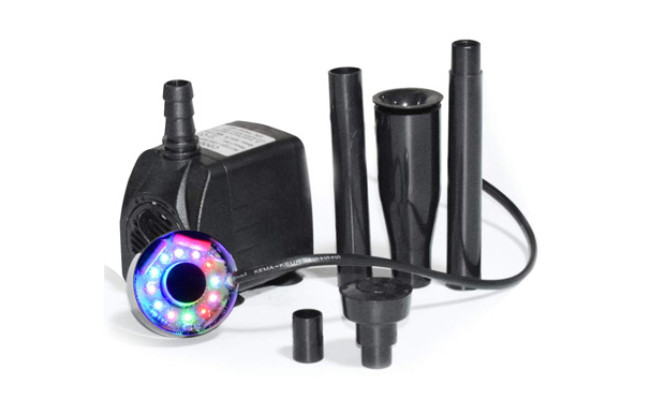
Safety is key, especially when introducing a new fixture into the aquatic habitat. That is why the COODIA 15W 200GPH Submersible Pump is designed with safety at its core. Not only is it anti-corrosive, it is also equally acid-resisting and long-lasting. Its general design fosters reliability while also being extremely quiet. Additionally, it features a 12RGB LED light ring that creates a pleasing visual effect.
That is not the only attachment it comes with, there are also accompanying blossom and mushroom fountain heads. Their heights are easily adjustable thanks to the generous addition of 3 extensions. With all these handy features, it is quite surprising that this pump is energy efficient thanks to its power-saving capabilities. It makes use of a maximum amount of AC 110V of power while providing 15 Watts of power. On top of all this, it is also easy to take apart when it’s time for some good old cleaning. Based on this its, efficiency is only topped by its user-friendliness.
Last but certainly not least, this submersible pump is nothing if it is not versatile, it can be used in both fresh and saltwater aquariums.
Anti-corrosive and acid-resistant
Quiet
Makes use of a maximum amount of AC 110V of power
Energy saving
- Brand: COODIA
- Weight: 14.4 ounces
Small but powerful
Good value for money
Incredibly easy to set up
It is not suited for small water features
The range of adjustment for water flow is limited
It is a bit flimsy
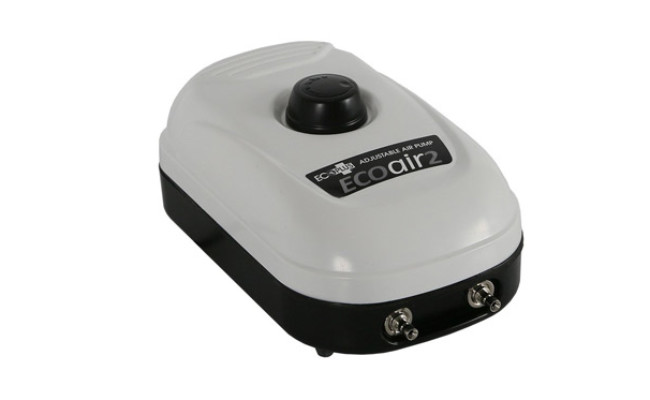
Oxygen supply is as vital underwater as it is above it. That’s no issue because the EcoPlus 126 GPH Air Pump can ensure that the flora and fauna in your aquarium have access to enough of it. This device is known for its ability to supply the optimum amount of oxygen to the inhabitants of aquariums, fish farms, indoor gardens as well as hydroponic systems. Not only does it run smoothly, but it is easily operated with little to no oil and with even less noise. Its noiseless nature can be credited to the fact that it is fitted with a double damping noise reduction system.
Additionally, this high energy aquarium water pump is fitted with two chambers which provide a well-blended combination of high outputs as well as stable pressure. Despite the fact that this device does not need a whole lot of oil, it is a well-oiled machine in a proverbial sense. The general design of this water pump features a sturdy water-resistant housing because accidents do happen. Also, the cylinders and pistons are made from high-quality materials which work together to make it a strong and durable pump.
Supplies optimum oxygen
Little to no oil required
Sturdy, water-resistant construction
Strong, durable pump
- Brand: EcoPlus
- Model: 728360
- Weight: 1.4 pounds
Cleans out ponds and tanks wonderfully
Great value for money
It is powerful
It tends to heat up easily
Durability is questionable
It is noisy
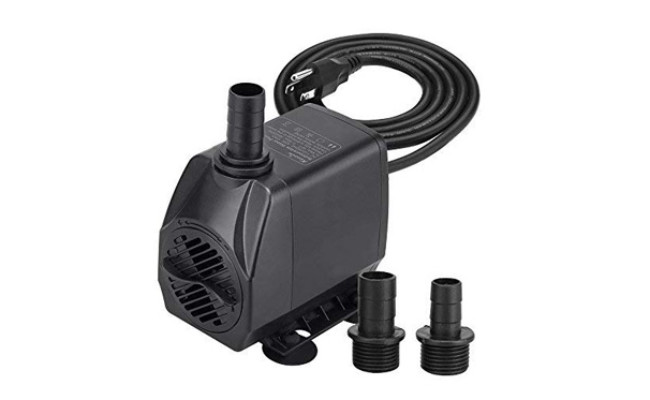
It is a hassle to get the right pump for little bodies of water. But the havoc caused by more powerful options is a thing of the past thanks to the stellar workings of the KEDSUM 880GPH Submersible Pump. This is the perfect fit if you are the owner of Nano to medium sized aquariums, a water garden, a small pond, a spout, a hydroponic system or even a desktop water fountain. Big is not always better, thanks to the compact size of this water pump, it is not just easy to hide inside the water tank, but it is also incredibly easy to clean. The fact that it is detachable goes a long way to ensure that the cleaning process is a lot more streamlined.
This may not have much to do with the size, but it is equally very quiet, so it’s perfect for indoor use. For further convenience, it is fitted with a percolator which effectively ensures that the rotor stays unblocked by rubbish. It also has a total of 3 outlet adapters of different sizes which provide more options for your preferred water flow. This way, there is a hitch-free movement of water through and through.
Detachable pump
Fitted with a percolator
Comes with a total of 3 outlet adapters
Strong, durable pump
- Brand: KEDSUM
- Model: KDF278-D08V045B
- Weight: 2.2 pounds
It is incredibly powerful
Does not need that much de-clogging
It has a good build and structure
Causes a lot of water vibration
The water pressure is low
It is incredibly loud
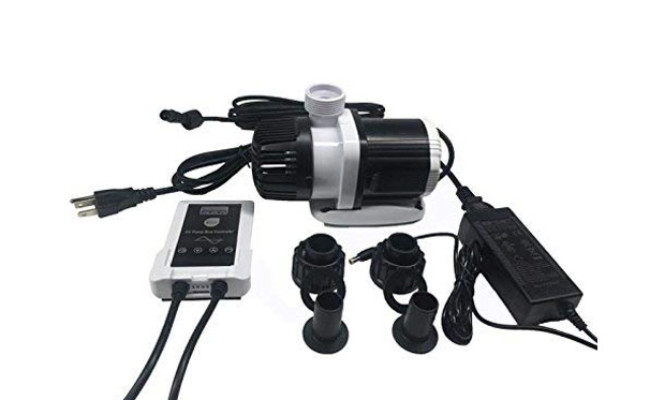
As astonishing as it may be, the answer to your water aquarium pump needs could simply fit in the palm of your hands. The Aquastation Silent Swirl Controllable DC Aquarium Pump is the embodiment of the term ‘small but mighty.’ With the maximum flow rate of 1056 GPH and a maximum lift head of 11.5 feet, it goes without saying, it is full of pleasant surprises. In addition to all this, it features a total of three pump modes, the steady flow, wave, and feed mode. The great part of it all is that despite being able to achieve so much, it saves up to 65% energy more than most traditional water pumps. It makes use of a low amount of voltage which makes it quite a safe option.
It is also incredibly silent and as such is perfect for indoor use, be it in marine or freshwater tanks. Its versatility does not end there, it is a submersible and inline water pump wrapped up in one. With its run dry protection, it can safely work both on the inside and outside of your fish tank. To top it all off, it offers up 20 different speed settings, while also giving way for specific adjustments to be made to the water flow.
Maximum flow rate of 1056 GPH
maximum lift head of 11.5 feet
Saves up to 65% energy more than most traditional water pumps
Low voltage
- Brand: aquariumstation
- Weight: 3.97 pounds
It is quiet and powerful
Easy to operate the two available modes
The cords are nice and long
It is leaky
The directions are quite vague
Short lifespan
Best Aquarium Pump Buying Guide & FAQ
Picking an aquarium pump is no easy feat, especially since it plays a vital role in making their habitat more conducive. Keeping that water moving along is an important duty and leaving it on the hand of any old water pump could be perilous. To avert that, here are some pointers to make the search a bit easier.
What to Look for in an Aquarium Water Pump
- Flow Rate
This is all dependent on the flora and fauna present in the fish tank. In the case that they are saltwater fish, then your target is something with a high flow rate. On the other hand, for freshwater fish and a planted aquarium, the flow rate should be minimal. To get the best option, find out more about the inhabitants of your aquarium and the conditions they need to thrive.
- The ratio of its Strength to the Size of the Aquarium
The strength of water pumps varies for each product, this is because of the different tank sizes. The general rule of thumb here is, the larger the aquarium, the stronger the water pump. This way, its efforts won’t come off as subpar. If the tank is too large for the power of the pump, it could end up working overtime. On the flip side, too much power could be hazardous.
- Noise Level
Depending on where the pump will be used it may not really make much of a difference. For instance, in a fishpond located outdoors, the noise would not be much of a bother. But if it’s a tank in the living room it bedroom, the noise level is an important factor. Be sure to check not only the description but the reviews to guarantee that the noise is bearable.
- Type of Installation
Aquarium water pumps are either submersible or inline, in terms of installation. When a pump is inline that means it cannot be fully submerged under water. So, what’s the difference between the pair, apart from their buoyancy? Submersible pumps tend to run a lot quieter, but that may not be much of a bother for everyone. So, simply determine which installation route is most suitable and make a purchase based on that.
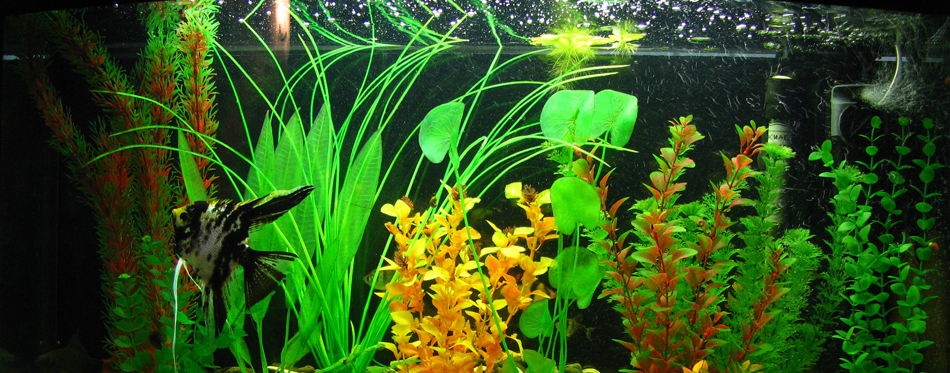
Different Types of Aquarium Pumps
- Inline Water Pump
This type of aquarium water pump is placed outside of the tank. It’s great because it can get cooled by the air around it. So, it’s less likely to increase the temperature inside the aquarium. It also has the ability to move more gallons of water per hour. On the downside, it’s noisy.
- Submersible Water Pump
This option runs under water and is often used in the sump of a wet or dry filter. This option is preferable because the installation process is simple. Additionally, it makes less noise since it’s underwater. The main downside is that it heats up a lot, making the fish tank quite uncomfortable.
- Air Pumps
An air pump functions by forcing air from the atmosphere into the fish tank. The whole process is quite mechanical, yet this is one of the most basic contraptions placed in an aquarium. Once the air is forced in, water motion is created as the air bubbles rise to the surface. Not only is this soothing to watch, but it also supplies the fish and plants with oxygen.
How to Install the Aquarium Water Pump
If it’s submersible, then you picked the easy route. Simply stick the suction cups/magnets to their designated position, ensuring that it is a space capable of holding them. Once the suction cups or magnets have a firm footing the installation process is over. It’s a bit more complicated for inline pumps, first, you need to find the perfect position for them, somewhere they can be guarded against the water. The best way is to fit the pump directly onto the filtering system by drilling a hole into the sump filter.
Benefits of Aquarium Pumps
It’s important to remember, as mentioned in the introduction, that the bubbles created by an aquarium pump don’t actually feed the fish oxygen directly. What an aquarium pump (or aquarium powerhead) does is to send bubbles up to the water surface which then pop; and this bursting action creates surface movement. That will help promote oxygenation, in other words the exchange of gases between the water and the atmosphere beyond.
The main benefit of an aquarium pump, therefore, is to address the issue of there being insufficient water surface movement within the tank itself.
Factors that increase the likelihood of this occurring include the number of fish in the tank and the temperature of the water. In essence, the more fish you have, the more oxygen they’ll need to thrive and survive. And the higher the temperature of the water within the aquarium, the greater the amount of water surface movement is required to maintain sufficient levels of oxygen within the water.
Related Post: Aquarium LED Lighting
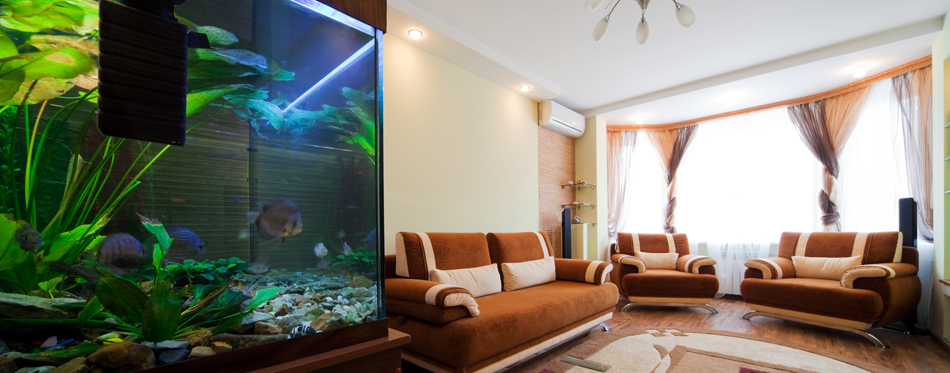
Best Aquarium Pump FAQ:
Q: How Does an Aquarium Water Pump Work?
A: The general gist is that they channel water in and out of aquarium filtration systems. Since there are different types of pumps, they all work differently. Air pumps function by using the force that air puts on the water in a tube. Once the air is pumped into the tube, the bubbles pull the water along as they rise. Inline pumps work by making use of an inlet and outlet hose to adequately filter the water in the tank. Then the submersible one’s clean water by sending it through a filter. Then proceed to push the clean water back into the aquarium.
Q: Where should I place my aquarium pump?
A: It’s important that your aquarium pump works in harmony with your filter outlet. The idea is to improve the water circulation within the tank, and so for best effect, you should ensure that your pump points in the same direction as the filter. Therefore, if your filter is on the left hand side and points out to the right, then the pump should also be positioned on the left, with the water flow exiting to the right.
If you position it anywhere else within the tank, particularly at the opposite end, then this will only hamper the circulation of the water and increase the possibility of ‘dead spots’.
Related Post: Best Aquarium Substrate
Q: What size do I need?
A: As a general rule of thumb, you should aim for your pump to be capable of turning over the volume of water in your aquarium five times every hour. First, establish how many gallons your tank holds. Then multiply that by five to get the minimum flow rate in gallons per hour (GPH). So for a 20 gallon tank, you will need a pump that is capable of producing at least a minimum flow rate of 100 GPH.
There are other factors that may affect the flow rate, though. These might include elbows and turns in the plumbing, for instance, or fitted filters. That’s why it’s always better to opt for a pump that has a slightly larger flow rate than you think you need. If your pump is too weak, it’s impossible to increase water flow. However, it is possible to reduce the water flow from a more powerful pump if you need to – either by buying a model that has an adjustable flow rate or by installing a ball valve on the pump’s outlet side.
Q: How loud are aquarium water pumps?
A: No aquarium pump is going to be completely silent. If noise is a major concern, you can opt for a submerged pump, which will generally be quieter than an in-line unit while in operation. However, placement of the pump within your tank will obviously take up more space and also may increase the temperature of the water.
While an in-line aquarium pump will not affect water temperature, it’s likely to be noisier while in operation. Additionally, they may need more plumbing work to fit them, as the pump needs water to operate. This might involve drilling a hole in the filter sump.
Related Post: Best Aquarium Heater
Q: How do I clean my aquarium pump?
A: Broadly speaking, all air pumps should be cleaned every six to twelve months to avoid deposits, dirt and grime that may reduce the efficiency of the way they operate. You may also notice your pump becomes much noisier when it’s in use – another sure sign it’s time for a clean.
Your first port of call should be the manufacturer’s instructions, as every pump is different. You can also check out online forums to get hints and tips from other users of pumps like yours.
In general terms, there are a few steps to go through to complete this process. First, always make sure the pump is unplugged and removed from your tank. Many good pumps have a cover that’s easily removed to allow you access to the impeller, the moving part that transmits energy between the motor and the water being pumped. Remove the impeller itself or the entire workings and closely inspect for damage. The parts can then be soaked in a cleaning solution. For lightly soiled units, a solution of white distilled vinegar and water should be enough to remove deposits. Tougher stains and marks may need an acidic cleaning solution. Leave for a few hours or until the deposits are easy to remove. Either way, ensure the cleaning solution is properly rinsed off before carefully reassembling the aquarium air pump. There’s a likelihood that acidic solutions especially may damage the delicate parts if left on too long.

Our Top Pick
Our pick of the aquarium pumps on the market is the Simple Deluxe 1056 GPH Listed Submersible Pump. Popular with a whole host of buyers from all backgrounds and for all purposes, this fish tank filter pump packs in an impressive range of features for your money and for keeping your aquarium aerated, from its pre-filter that’s designed to maximize the life of your product to its ease of maintenance and the 15ft waterproofed power cord. All in all, a great buy.
A freelance writer and word nerd, Wendy is a content writer with a knack for getting into the nitty-gritty of pet ownership. For the past three years, she’s been researching and writing a huge range of different topics – but always comes back to her beloved pet articles. Lover of all things four-legged and owner of Harley, Pepper and Rush, Wendy is currently completing her MNSW at Edge Hill University.
Related Posts
